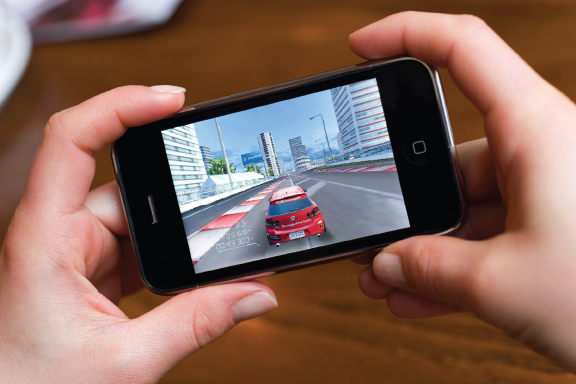Convergence: From Consoles to Mobile Gaming
“The Xbox has never been a game system. The Xbox is Microsoft’s idea lab. It’s the one market where Microsoft is indisputably considered both serious and cool.”
TIM CARMODY, WIRED, MARCH 2012
Digital games made their initial appearances on computers and consoles, and were very much wedded to those platforms. Today, though, games can be consumed the same way so much music and so many books, television shows, and films are consumed: just about anywhere, and in a number of different ways. And video game consoles are increasingly part of the same technological convergence that gives devices like smartphones and tablets multiple functions.
Consoles Become Entertainment Centers
Video game consoles, once used exclusively for games, now work as part computer, part cable box. They’ve become powerful entertainment centers, with multiple forms of media converging in a single device. For example, the Xbox One and PS4 can function as DVD players and digital video recorders (with hard drives of up to 250 gigabytes) and offer access to Twitter, Facebook, blogs, and video chat. The PS4 can also play Blu-ray discs, and all three console systems offer connections to stream programming from sources like Netflix and Hulu Plus. Microsoft’s Xbox, which offers the greatest selection of video channels (including ESPN, HBO Go, YouTube, SyFy, and Amazon Instant Video) and has Kinect’s voice recognition system for viewers to communicate with the box, has been the most successful in becoming a converged device for home entertainment. In 2012, for the first time, “subscribers to Xbox’s LIVE online service in the U.S. spent more time consuming video and music than multiplayer games,” Forbes magazine reported, declaring that “Microsoft Xbox is winning the living room war.”10
Portable Players and Mobile Gaming

Simple handheld players made games portable long before the advent of Internet-connected touchscreen mobile devices. Nintendo’s Game Boy, a two-color handheld console introduced in 1989, was one early success and popularized the game Tetris, which came preloaded on it. The early handhelds gave way to later generations of devices offering more advanced graphics and wireless capabilities. These include the top-selling Nintendo 3DS, released in 2011, and PlayStation Portable (PSP), released in 2005 and succeeded by the PlayStation Vita in 2012. Both brands are Wi-Fi capable, so players can interface with other users to play games or browse the Internet.
While portable players remain immensely popular (the Nintendo DS sold more than 154 million units through 2013), they face competition from the widespread use of smartphones and touchscreen tablets like iPads. These devices are not designed principally for gaming, but their capabilities have given casual gamers who may not have been interested in owning a handheld console another option. Manufacturers of these converged devices are catching on to their gaming potential: After years of relatively little interest in video games, Apple introduced Game Center in 2010. This social gaming network enables users to invite friends or find others for multiplayer gaming, track their scores, and view high scores on a leader board—which the DS and PSP do as well. With more than 284 million iPhones and 100 million iPads sold worldwide by 2013 (and millions more iPod Touch devices in circulation), plus nearly 150,000 games (like Where’s My Mickey? and Bus Derby) available in its App Store, Apple’s devices, games, and distribution system are transforming the portable video game business.11 Handheld video games have made the medium more accessible and widespread. Even people who wouldn’t identify themselves as gamers may kill time between classes or waiting in line by playing Angry Birds on their phones.
Google Play (formerly the Android Market) rivals Apple’s App Store in its number of apps and provides a substantial platform for gaming on Android mobile phones and tablet devices like the Kindle, Nook, and Galaxy. Microsoft is also looking to improve its new generations of Windows Phones to better interface with its Xbox 360 entertainment system.
This convergence is changing the way people look at video games and their systems. The games themselves are no longer confined to arcades or home television sets, while the latter have gained power as entertainment tools, reaching a wider and more diverse audience. Many phones and PDAs operate as de facto handheld consoles, and many home consoles serve as comprehensive entertainment centers. Thus, gaming has become an everyday form of entertainment, rather than the niche pursuit of hard-core enthusiasts.
With its increased profile and flexibility across platforms, the gaming industry has achieved a mass medium status on a par with film or television. This rise in status has come with stiffer and more complex competition, not just within the gaming industry but across media. Rather than Sony competing with Nintendo, or TV networks competing among themselves for viewers, or new movies facing off at the box office, media must now compete against other media for an audience’s attention.